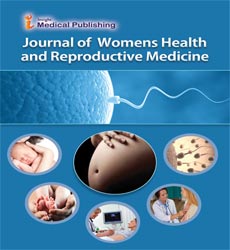Ovarian Self-Assembly: Reconstitution without Surface Epithelium
Sophia Morgan*
Department of Women's Health, University of Newcastle, Callaghan, Australia
- *Corresponding Author:
- Sophia Morgan
Department of Women's Health,
University of Newcastle, Callaghan,
Australia,
E-mail: Morgan@gmail.com
Received date: February 21, 2024, Manuscript No. IPWHRM-24-18747; Editor assigned date: February 24, 2024, PreQC No. IPWHRM-24-18747 (PQ); Reviewed date: March 09, 2024, QC No. IPWHRM-24-18747; Revised date: March 16, 2024, Manuscript No. IPWHRM-24-18747 (R); Published date: March 23, 2024, DOI: 10.36648/ipwhrm.8.1.84
Citation: Morgan S (2024) Uterine Segmentation via Weakly Supervised Scribble Labeling. J Women’s Health Reprod Med Vol.8 No.1: 84.
Introduction
The capacity to produce 3-Dimensional (3D) mammalian models of organogenesis in laboratory settings has revolutionized biomedical research by allowing for the recreation of sufficient cellular complexity to mimic crucial aspects of tissue development outside the organism. While most 3D cell and tissue models of the ovary have concentrated on the development and maturation of postnatal or adult ovarian follicles, which serve as the ovary's functional units, the reconstituted ovary (rOvary) presents a comprehensive model of ovarian organogenesis. This model is created through the self-assembly of germ cells derived from Pluripotent Stem Cells (PSCs) with a singlecell suspension of embryonic ovarian somatic cells. It encompasses the in vitro specification of germline cells all the way to the self-assembly of ovarian follicles capable of in vitro fertilization. Given its accessibility, the rOvary technology shows significant potential as a screening platform for the discovery, testing, and advancement of therapeutics aimed at enhancing family planning and reproductive health. Therefore, it is crucial to thoroughly understand the biology of the rOvary. The mammalian ovary develops from two distinct embryological origins: the germline, originating from Primordial Germ cells (PGCs), and the ovarian somatic support cells, originating from bilateral genital ridges. In mouse embryos, PGCs are specified between E6.25 and E7.5 from the posterior epiblast and initially settle in the allantois before migrating into the developing embryo towards the genital ridges.
Genital ridges
Upon entering the genital ridges around E10.5, Primordial Germ cells begin expressing the Primordial Germ cell determination gene Dazl and proliferate as germline cysts within developing epithelial niches known as ovigerous cords, originating from the GATA4+ ovarian epithelium. Between E12.5 and E14.5, the germline cyst cells respond to retinoic acid, and the germ cells enter prophase I of meiosis I, remaining arrested at this stage until birth. At birth, the ovigerous cords, containing pre-granulosa cells and meiotic oocytes, disintegrate, initiating the formation of ovarian follicles. Some follicles promptly activate, beginning folliculogenesis and recruiting the cells from the stroma, termed first-wave follicles. However, the majority of follicles remain quiescent, constituting the ovarian reserve. Examination of rOvaries reveals a deficiency in establishing dormant follicles. Consequently, it is plausible to propose that the rOvary model represents the prepubescent phase of activated folliculogenesis. The rOvary technology is intriguing as it facilitates the reconstruction of the entire germline differentiation pathway, including follicle formation, entirely in vitro. Notably, the oocytes generated in this model exhibit competence for in vitro maturation, fertilization, and ultimately the birth of viable offspring. However, comprehending the potential biomedical applications of rOvaries in research necessitates a comprehensive understanding of both in vitro and in vivo ovarian morphogenesis.
Ovarian epithelium
In this investigation, we utilized the Fiber Optic Splice Closure (FOSC) model to create ovaries, aiming to analyze the cellular constituents both before and after follicle self-assembly. Our focus was on assessing the ovarian surface epithelium, which gives rise to pre-granulosa cells during the second wave, along with the stroma and theca cells. Our findings reveal that the ovarian surface epithelium is absent upon the completion of ovary formation. Additionally, although Nuclear Receptor Subfamily 2 Group F Member 2 (NR2F2+) stromal fibroblasts are present amidst the activated follicles, there is no recruitment of steroidogenic theca cells. At day 6 of the differentiation process, utilizing 10X Genomics, consistently across experiments, 10 clusters revealed the presence of 5 primary cell types. These include a predominant group characterized by Tbx4+/Hand1+ mesoderm, a smaller subset identified as Kdr+/Tal1+ mesoderm, a presumed population of Tfap2c+/Hand1+ trophoblast/amnion cells, and two groups exhibiting a pluripotency profile marked by Oct 4. The mesoderm population expressing Tbx4, a transcription factor typically found in the posterior allantoic mesoderm and vascular segments of the placenta, was notably abundant. This observation implies a similarity between the somatic niche formation and mesoderm development, where Primordial Germ Cell-Like Cells (PGCLCs) initially localize following specification in vivo.
Open Access Journals
- Aquaculture & Veterinary Science
- Chemistry & Chemical Sciences
- Clinical Sciences
- Engineering
- General Science
- Genetics & Molecular Biology
- Health Care & Nursing
- Immunology & Microbiology
- Materials Science
- Mathematics & Physics
- Medical Sciences
- Neurology & Psychiatry
- Oncology & Cancer Science
- Pharmaceutical Sciences
